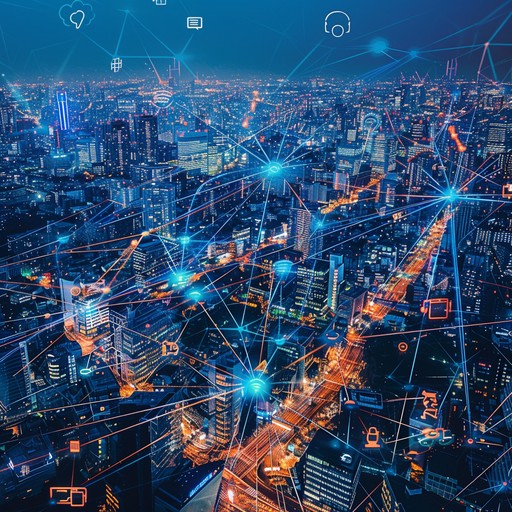In an era where data is the new oil, the intersection of Artificial Intelligence (AI), the Internet of Things (IoT), and edge computing is not just an emerging trend—it's a revolutionary paradigm shift. Together, these technologies are enabling the creation of hyper-aware systems that can sense, analyze, and react to their environments in real-time. This convergence is reshaping industries, redefining efficiencies, and challenging our understanding of automation and data-driven decision-making. In this post, we will explore the foundational concepts, current innovations, challenges, and the transformative potential of these synergistic technologies.
Understanding the Foundations
Artificial Intelligence (AI)
AI refers to systems designed to perform tasks that typically require human intelligence. Through machine learning, deep learning, natural language processing, and computer vision, AI systems can learn from data, detect patterns, and make decisions with remarkable accuracy. In the context of hyper-aware systems, AI acts as the analytical brain that transforms raw sensor data into actionable insights.
The Internet of Things (IoT)
IoT encompasses the network of interconnected devices that collect and exchange data over the internet. From smart home appliances and wearable technology to industrial sensors and smart cities, IoT devices capture an immense amount of data from the physical world. This data becomes the lifeblood for AI algorithms, providing the context needed for intelligent decision-making.
Edge Computing
Traditional cloud computing models rely on centralized data processing. However, edge computing shifts much of the processing power closer to the data source—the "edge" of the network. By processing data locally, edge computing reduces latency, enhances privacy, and allows for real-time decision-making. This capability is critical for applications where even milliseconds matter, such as autonomous vehicles or industrial automation.
The Convergence: Synergy in Action
Real-Time Analytics and Decision-Making
When AI, IoT, and edge computing converge, they enable systems that are not only data-rich but also contextually smart. For instance, in industrial settings, IoT sensors continuously monitor machinery conditions. Edge computing allows for rapid processing of this data on-site, while AI algorithms quickly diagnose potential issues, predict failures, and optimize maintenance schedules. This seamless interaction results in systems that can anticipate and mitigate downtime before it becomes a critical issue.
Enhanced Contextual Awareness
Hyper-aware systems leverage the constant inflow of data from IoT devices to build a comprehensive picture of their environment. AI models analyze this multi-dimensional data to identify trends, detect anomalies, and recognize patterns that would be impossible for a human operator to discern. This heightened level of awareness is essential for smart cities, where managing traffic, monitoring public safety, and optimizing energy usage rely on the continuous interpretation of diverse data streams.
Optimized Resource Allocation
In retail, healthcare, and logistics, the integration of edge computing and AI enables dynamic resource allocation. Retailers, for example, can use AI to analyze customer behavior data captured by in-store sensors, then combine it with external environmental factors processed at the edge (such as weather conditions or local events) to dynamically optimize staffing levels and inventory. In healthcare, wearable devices collect vital signs, and edge devices immediately process that data to alert medical personnel if anomalies are detected, ensuring timely interventions.
Decentralized Intelligence
One of the most transformative aspects of this convergence is the emergence of decentralized intelligence. Instead of relying solely on centralized cloud models, hyper-aware systems distribute processing across various nodes. This decentralization not only enhances privacy and security by minimizing the data transmission over networks but also ensures that even if a central server fails, localized processing continues uninterrupted. Industries such as autonomous driving and robotics have already begun to leverage these capabilities to enhance system resilience and reliability.
Challenges on the Horizon
Data Security and Privacy
In hyper-aware systems, massive volumes of personal and sensitive information are processed at unprecedented speeds. Ensuring that this data is secure, particularly when processed at the edge, requires robust encryption methods, stringent access controls, and real-time threat detection mechanisms. As these systems become more prevalent, developing best practices for data protection will be paramount.
Interoperability and Standardization
A key challenge in creating hyper-aware systems is the diversity of devices, communication protocols, and data formats in IoT ecosystems. For seamless integration, standardization across different platforms and manufacturers is crucial. The industry is gradually moving towards unified frameworks, but achieving global consensus on standards remains a work in progress.
Computational Constraints and Energy Efficiency
While edge devices are improving in computational power, they still face constraints in processing capacity and energy consumption compared to centralized cloud infrastructure. Striking the right balance between on-device processing and cloud offloading is essential to ensure that systems remain both efficient and effective, particularly in remote or resource-constrained environments.
AI Model Complexity and Interpretability
As AI models become more sophisticated, ensuring that their decision-making processes are transparent and interpretable becomes a significant challenge. For critical applications such as healthcare or autonomous systems, understanding how and why an AI system made a particular decision is essential for trust, regulatory compliance, and further refinement of the models.
Pioneering Applications and Future Prospects
Smart Cities and Urban Management
Hyper-aware systems are set to redefine urban life. In smart cities, a network of sensors, cameras, and connected devices can monitor everything from traffic flow and public transportation to air quality and energy usage. AI algorithms process this data at the edge, enabling city administrators to make real-time decisions that improve urban efficiency, reduce congestion, and enhance environmental sustainability.
Industrial Automation and Predictive Maintenance
Industries are increasingly adopting smart factories where every machine and process is connected. Through continuous monitoring and analysis at the edge, AI-powered systems can predict when equipment is likely to fail, schedule maintenance proactively, and minimize production downtime—driving operational efficiency and cost savings.
Healthcare Transformation
From remote patient monitoring to smart diagnostics, hyper-aware systems in healthcare promise to improve patient outcomes significantly. Wearable devices and smart medical equipment transmit real-time data, which is then processed locally to provide immediate alerts and insights. This real-time analysis is crucial for managing chronic conditions and responding swiftly to emergencies.
Autonomous Systems and Robotics
The convergence of AI, IoT, and edge computing is fundamental to the evolution of autonomous systems. Self-driving cars, drones, and industrial robots rely on instantaneous data processing to navigate complex environments safely. Edge computing, in particular, ensures that these systems can operate independently in environments where connectivity to the central cloud is limited or intermittent.
Concluding Thoughts
The melding of AI, IoT, and edge computing marks a turning point in our technological evolution. By fusing data acquisition, localized processing, and intelligent analytics, we are creating systems that are not just reactive but proactively aware of their surroundings—a leap towards true situational awareness. These hyper-aware systems promise improvements in efficiency, safety, and quality of life across various domains, ushering in an era of unprecedented connectivity and intelligence.
However, as with any transformative technology, careful attention must be paid to security, standardization, and ethical considerations. Overcoming these challenges will require collaboration across disciplines and industries. The future of hyper-aware systems is not just about technological prowess; it is about building intelligent, safe, and sustainable environments where data drives informed decisions and enriches human experiences.
In this convergent landscape, as each piece—AI, IoT, and edge computing—plays its part, they collectively transform the ordinary into the extraordinary, heralding a future where our systems are as dynamic and responsive as the world around us.

